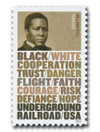
# 5836 - 2024 First-Class Forever Stamp - William Still, Underground Railroad
US #5836
2024 William Still – Underground Railroad
• Honors William Still and the many people he helped reach freedom through the Underground Railroad
Stamp Category: Commemorative
Set: Underground Railroad
Value: 68¢ First Class Mail Rate (Forever)
First Day of Issue: March 9, 2024
First Day City: Church Creek, Maryland
Quantity Issued: 20,000,000
Printed by: Ashton Potter (USA) Ltd.
Printing Method: Offset
Format: Panes of 20
Watermark: Nonphosphored Type III, Block Tag Applied
Why the stamp was issued: To commemorate Underground Railroad conductor William Still, and the 600+ people he helped to freedom.
About the stamp design: Pictures a sepia-toned portrait of William Still along with eight lines of text which read: BLACK/WHITE; COOPERATION; TRUST/DANGER; FLIGHT/FAITH; COURAGE/RISK; DEFIANCE/HOPE; UNDERGROUND; RAILROAD/USA. Designed by Antonio Alcalá using an existing image.
Special design details: On the reverse side of the pane of 20, there is a map picturing routes taken on the Underground Railroad from the South to North. The reverse side also includes a list of people pictured on the stamps plus biographical information on them.
First Day City: The First Day of Issue Ceremony was held at the Harriet Tubman Underground Railroad Visitor Center in Church Creek, Maryland.
About the Underground Railroad set: Pictures 10 people who made their way to freedom or helped others reach freedom through the Underground Railroad. Includes: Harriet Tubman, Thomas Garrett, William Still, Harriet Jacobs, Jermain Loguen, Catherine Coffin, Lewis Hayden, Frederick Douglass, William Lambert, and Laura Haviland.
History the stamp represents: William Still (October 2, 1821 – July 14, 1902) was a Black abolitionist and conductor of the Underground Railroad. In his lifetime, he helped at least 649 escaped slaves reach freedom in the North. He was also a businessman, writer, historian, and civil rights activist.
Still was born in Shamong Township, New Jersey, to former slaves Charity and Levin Still. He was the youngest of 18 children. When he was 23, Still moved to Philadelphia, Pennsylvania. There, he became a clerk for the Pennsylvania Society for the Abolition of Slavery and met his wife, Letitia George. Still helped organize a local Vigilance Committee to aid fugitive slaves and eventually became its chairman.
Still and his wife moved to 625 South Delhi Street and turned their house into an Underground Railroad Way Station. One of the most famous escaped slaves who came through their station was Jane Johnson. Her enslaver had brought her to the free state of Pennsylvania, allowing Still and others to successfully free her and her two sons under state law. Still and five other Black abolitionists were sued by Johnson’s enslaver, but only two served jail time (one week).
Still continued his activism for the rest of his life. In fact, it was through his efforts that streetcars became racially integrated throughout the state of Pennsylvania.
US #5836
2024 William Still – Underground Railroad
• Honors William Still and the many people he helped reach freedom through the Underground Railroad
Stamp Category: Commemorative
Set: Underground Railroad
Value: 68¢ First Class Mail Rate (Forever)
First Day of Issue: March 9, 2024
First Day City: Church Creek, Maryland
Quantity Issued: 20,000,000
Printed by: Ashton Potter (USA) Ltd.
Printing Method: Offset
Format: Panes of 20
Watermark: Nonphosphored Type III, Block Tag Applied
Why the stamp was issued: To commemorate Underground Railroad conductor William Still, and the 600+ people he helped to freedom.
About the stamp design: Pictures a sepia-toned portrait of William Still along with eight lines of text which read: BLACK/WHITE; COOPERATION; TRUST/DANGER; FLIGHT/FAITH; COURAGE/RISK; DEFIANCE/HOPE; UNDERGROUND; RAILROAD/USA. Designed by Antonio Alcalá using an existing image.
Special design details: On the reverse side of the pane of 20, there is a map picturing routes taken on the Underground Railroad from the South to North. The reverse side also includes a list of people pictured on the stamps plus biographical information on them.
First Day City: The First Day of Issue Ceremony was held at the Harriet Tubman Underground Railroad Visitor Center in Church Creek, Maryland.
About the Underground Railroad set: Pictures 10 people who made their way to freedom or helped others reach freedom through the Underground Railroad. Includes: Harriet Tubman, Thomas Garrett, William Still, Harriet Jacobs, Jermain Loguen, Catherine Coffin, Lewis Hayden, Frederick Douglass, William Lambert, and Laura Haviland.
History the stamp represents: William Still (October 2, 1821 – July 14, 1902) was a Black abolitionist and conductor of the Underground Railroad. In his lifetime, he helped at least 649 escaped slaves reach freedom in the North. He was also a businessman, writer, historian, and civil rights activist.
Still was born in Shamong Township, New Jersey, to former slaves Charity and Levin Still. He was the youngest of 18 children. When he was 23, Still moved to Philadelphia, Pennsylvania. There, he became a clerk for the Pennsylvania Society for the Abolition of Slavery and met his wife, Letitia George. Still helped organize a local Vigilance Committee to aid fugitive slaves and eventually became its chairman.
Still and his wife moved to 625 South Delhi Street and turned their house into an Underground Railroad Way Station. One of the most famous escaped slaves who came through their station was Jane Johnson. Her enslaver had brought her to the free state of Pennsylvania, allowing Still and others to successfully free her and her two sons under state law. Still and five other Black abolitionists were sued by Johnson’s enslaver, but only two served jail time (one week).
Still continued his activism for the rest of his life. In fact, it was through his efforts that streetcars became racially integrated throughout the state of Pennsylvania.











